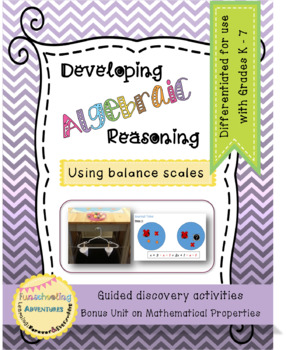Developing Algebraic Reasoning with Balance Scales K - 8 distance learning Math
- PDF
Also included in
- This bundle for Algebra 1 includes project based learning activities, an ebook for teaching Algebraic concepts using a balance scale, interactive notes with templates for teaching, whole class activities, and more. This bundle includes my best-selling resource: Marketing Plan - Algebra project. ----Price $15.00Original Price $18.75Save $3.75
Description
Great for use at home if you're stuck in a Coronavirus quarantine and want fun Math for your kids. If you are a teacher, tutor, or homeschooling parent looking for an engaging way to introduce your students to the foundations of Algebraic thinking, I believe that you will find this resource very helpful. Based on my experience teaching high school Algebra and homeschooling my own children, I have created this activity based lesson pack to help you take your students through the amazing journey of thinking abstractly, reasoning mathematically, and communicating effectively while exploring hands-on activities (with candy!). I have scaffolded the lessons so that students of any age can complete and understand the lessons; younger students can explore ideas tangibly and intuitively while older students will see connections to other math concepts and will learn to confidently manipulate equations to solve for a single variable based on a strong visual and concrete understanding.
Introduction to the Mathematical Property of Equality
One of the core “pillar concepts” in math is Equality. In the early grades, the equals sign is used to represent the answer to a problem. For instance, we learned early on that 1 + 2 = 3. Extending the idea further, however, the equals sign comes to mean that both sides of the equation are balanced; therefore, whatever mathematical operation is done to one side must be done to the other side. Although this may seem like a basic idea, many students work their way through years of math without truly understanding this concept. This lack of a solid foundation then becomes a handicap to them as they advance into Algebra and higher levels of math.
The activities laid out here can be started with beginning learners (as young as 5) but the extension activities can be used with students up through Algebra. The sooner that students are introduced to these concepts, the stronger their foundation will be in math, and the faster they can progress through the following modules, lessons, and extension activities.
_____________________________________________
** This is part of my growing bundle on Algebra 1 resources. See it here. **
Remember to leave feedback to earn TPT store credit towards future purchases! :)






